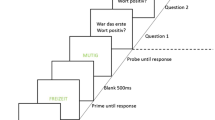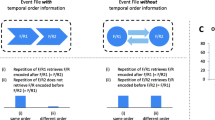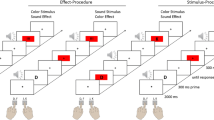Abstract
Two experiments studied the degree to which the creation and retrieval of episodic feature bindings is modulated by attentional control. Experiment 1 showed that the impact of bindings between stimulus and response features varies as a function of the current attentional set: only bindings involving stimulus features that match the current set affect behavior. Experiment 2 varied the time point at which new attentional sets were implemented—either before or after the processing of the to-be-integrated stimuli and responses. The time point did not matter, suggesting that the attentional set has no impact on feature integration proper but controls which features get access to and can thus trigger the retrieval of bindings.







Similar content being viewed by others
Notes
Research on feature integration in perception (commonly in vision) does not make much contact with feature integration in action planning or across perception and action, and researchers tend to think of the underlying processes as very different. However, not only are the representations of actions no less distributed as the representations of objects (Hommel & Elsner, 2009), thus raising the same kind of binding problems (Stoet & Hommel, 1999), but the functional and computational logic underlying feature integration in creating cognitive representations of objects, action plans, and sensorimotor coordination patterns may well be equivalent (Hommel, 2004).
Among other things, the relative benefit of complete repetitions depends on the question whether selecting a response presupposes the mere activation of the relevant feature codes (as for example considered by Jolicœur, Tombu, Oriet & Stevanovski, 2002) or the completed integration of these codes (as suggested by Kahneman et al., 1992). Specific predictions, especially regarding the comparison with alternations, are further complicated by the observation that complete stimulus repetitions seem to induce a tendency to shortcut response selection (Bertelson, 1963; we will come back to this issue in the discussion of Experiment 2) and that alternations may benefit from “integrated competition” (Duncan, 1996), in the sense that a previously created binding between competing features may make it easier to reject them as “one unit”. Given these complications, we neglect the precise relationship between complete repetitions and alternations (which empirically often produce comparable results) but focus on the observation that, and the explanation, why partial repetitions produce worse performance than both complete repetitions and alternations.
This reasoning assumes that attentional sets are implemented immediately after cue processing, so that the presentation of both S1 and S2 falls under the same set. One may object that, given that the set was unnecessary for processing S1, it may not have been implemented before S1 processing was completed, so that processing S2 but not S1 took place under the respective set. This consideration can be tested by comparing trials in which the set was the same as in the trial before (set repetition trials) with trials in which the sets differed (set alternation trials). Experiment 1 will show that set repetitions and alternations produced pretty much the same result pattern, which renders the objection unfounded.
One might argue that a task cue that appears 500 ms after S1 onset may still affect S1–R1 integration, which may blur the distinction between early and late cues. Even though it is impossible to rule that out entirely, it is rather unlikely. First, processing and interpreting the task cue must have taken some time, we would guess more than 200 ms. Second, processing the auditory cue must have taken even longer, which is evident from the increase in mean RT, and yet this did not interact with binding effects. Third, task switching studies have shown that shifting attention from one dimension to another is a rather capacity demanding and slow process, often taking several hundred milliseconds (e.g., Meiran, 1996; Rogers & Monsell, 1995). Considering all these complications, we doubt that the attentional control settings that were signaled by late cues were up and running much earlier than at S2 presentation—a time point at which stimulus–response bindings already start to decay (Hommel & Colzato, 2004).
Note that there was an anomaly regarding the way task modulated shape/response interactions. With late cues, the interaction of shape and response repetition was pronounced under the shape task and negligible under the color task. This was the expected pattern—a mirror image of the findings for color/response interactions. With early cues, however, the interactions were equally pronounced under both tasks, even though this did not render the related four-way interaction with task and time point significant. We have no explanation for this particular pattern to offer but note that similar asymmetries between perceptual dimensions have been reported before (e.g., Hommel, 1998).
References
Bargh, J. A., & Ferguson, M. J. (2000). Beyond behaviorism: on the automaticity of higher mental processes. Psychological Bulletin, 126, 925–945.
Bertelson, P. (1963). S-R relationships and reaction times to new versus repeated signals in a serial task. Journal of Experimental Psychology, 65, 478–484.
Bogacz, R. (2007). Optimal decision-making theories: Linking neurobiology with behavior. Trends in Cognitive Sciences, 11, 118–125.
Botvinick, M. M., Braver, T. S., Barch, D. M., Carter, C. S., & Cohen, J. D. (2001). Conflict monitoring and cognitive control. Psychological Review, 108, 624–652.
Cohen, R., & Rist, F. (1992). The modality shift effect. Further explorations at the crossroads. Annals of the New York Academy of Sciences, 658, 163–181.
Cohen, A., & Shoup, R. (1997). Perceptual dimensional constraints on response selection processes. Cognitive Psychology, 32, 128–181.
Colzato, L. S., Fagioli, S., Erasmus, V., & Hommel, B. (2005). Caffeine, but not nicotine enhances visual feature binding. European Journal of Neuroscience, 21, 591–595.
Colzato, L. S., & Hommel, B. (2008). Cannabis, cocaine, and visuomotor integration: Evidence for a role of dopamine D1 receptors in binding perception and action. Neuropsychologia, 46, 1570–1575.
Colzato, L. S., Raffone, A., & Hommel, B. (2006). What do we learn from binding features? Evidence for multilevel feature integration. Journal of Experimental Psychology: Human Perception and Performance, 32, 705–716.
Colzato, L. S., van Wouwe, N. C., & Hommel, B. (2007). Feature binding and affect: Emotional modulation of visuo-motor integration. Neuropsychologia, 45, 440–446.
Cowey, A. (1985). Aspects of cortical organization related to selective attention and selective impairments of visual perception: A tutorial review. In M. I. Posner & O. S. M. Marin (Eds.), Attention and performance XI (pp. 41–62). Hillsdale: Erlbaum.
DeYoe, E. A., & Van Essen, D. C. (1988). Concurrent processing streams in monkey visual cortex. Trends in Neuroscience, 11, 219–226.
Duncan, J. (1996). Cooperating brain systems in selective perception and action. In T. Inui & J. L. McClelland (Eds.), Attention and performance XVI (pp. 549–578). Cambridge: MIT Press.
Eriksen, C. W., & Schultz, D. W. (1979). Information processing in visual search: A continuous flow conception and experimental results. Perception & Psychophysics, 25, 249–263.
Folk, C. L., Remington, R. W., & Johnston, J. C. (1992). Involuntary covert orienting is contingent on attentional control settings. Journal of Experimental Psychology: Human Perception and Performance, 18, 1030–1044.
Gratton, G., Coles, M. G. H., & Donchin, E. (1992). Optimizing the use of information: Strategic control of activation of responses. Journal of Experimental Psychology: General, 121, 480–506.
Hommel, B. (1998). Event files: Evidence for automatic integration of stimulus response episodes. Visual Cognition, 5, 183–216.
Hommel, B. (2004). Event files: Feature binding in and across perception and action. Trends in Cognitive Sciences, 8, 494–500.
Hommel, B. (2005). How much attention does an event file need? Journal of Experimental Psychology: Human Perception and Performance, 31, 1067–1082.
Hommel, B. (2007). Feature integration across perception and action: Event files affect response choice. Psychological Research, 71, 42–63.
Hommel, B., & Colzato, L. S. (2004). Visual attention and the temporal dynamics of feature integration. Visual Cognition, 11, 483–521.
Hommel, B., & Elsner, B. (2009). Acquisition, representation, and control of action. In E. Morsella, J. A. Bargh, & P. M. Gollwitzer (Eds.), Oxford handbook of human action (pp. 371–398). New York: Oxford University Press.
Hommel, B., Proctor, R. W., & Vu, K.-P. L. (2004). A feature-integration account of sequential effects in the Simon task. Psychological Research, 68, 1–17.
Jolicœur, P., Tombu, M., Oriet, C., & Stevanovski, B. (2002). From perception to action: Making the connection. In: W. Prinz & B. Hommel (Eds.), Common mechanisms in perception and action: Attention and performance XIX (pp. 558–586). Oxford: Oxford University Press.
Kahneman, D., Treisman, A., & Gibbs, B. J. (1992). The reviewing of object files: Object-specific integration of information. Cognitive Psychology, 24, 175–219.
Keele, S. W. (1972). Attention demands of memory retrieval. Journal of Experimental Psychology, 93, 245–248.
Logan, G. D. (1988). Toward an instance theory of automatization. Psychological Review, 95, 492–527.
Logan, G. D., Taylor, S. E., & Etherton, J. L. (1996). Attention in the acquisition and expression of automaticity. Journal of Experimental Psychology. Learning, Memory, and Cognition, 22, 620–638.
Maruff, P., Danckert, J., Camplin, G., & Currie, J. (1999). Behavioral goals constrain the selection of visual information. Psychological Science, 10, 522–525.
Mayr, U., Awh, E., & Laurey, P. (2003). Conflict adaptation effects in the absence of executive control. Nature Neuroscience, 6, 450–452.
Meiran, N. (1996). Reconfiguration of processing mode prior to task performance. Journal of Experimental Psychology. Learning, Memory, and Cognition, 22, 1423–1442.
Memelink, J., & Hommel, B. (2013). Intentional weighting: A basic principle in cognitive control. Psychological Research, 77, 249–259.
Milliken, B., Tipper, S. P., & Weaver, B. (1994). Negative priming in a spatial localization task: Feature mismatching and distractor inhibition. Journal of Experimental Psychology: Human Perception and Performance, 20, 624–646.
Park, D. C., & Kidder, D. (1996). Prospective memory and medication adherence. In M. Brandimonte, G. Einstein, & M. McDaniel (Eds.), Prospective memory: Theory and applications (pp. 369–390). Mahwah: Lawrence Erlbaum Associates.
Pösse, B., Waszak, F., & Hommel, B. (2006). Do stimulus–response bindings survive a task switch? European Journal of Cognitive Psychology, 18, 640–651.
Pratt, J., & Hommel, B. (2003). Symbolic control of visual attention: The role of working memory and attentional control settings. Journal of Experimental Psychology: Human Perception and Performance, 29, 835–845.
Remington, R. W., & Folk, C. L. (2001). A dissociation between attention and selection. Psychological Science, 12, 511–515.
Rogers, R. D., & Monsell, S. (1995). Costs of a predictible switch between simple cognitive tasks. Journal of Experimental Psychology: General, 124, 207–231.
Singer, W. (1994). The organization of sensory motor representations in the neocortex: A hypothesis based on temporal coding. In C. Umiltà & M. Moscovitch (Eds.), Attention and performance XV: Conscious and nonconscious information processing (pp. 77–107). Cambridge: MIT Press.
Spapé, M., & Hommel, B. (2008). He said, she said: Episodic retrieval induces conflict adaptation in an auditory Stroop task. Psychonomic Bulletin & Review, 15, 1117–1121.
Stoet, G., & Hommel, B. (1999). Action planning and the temporal binding of response codes. Journal of Experimental Psychology: Human Perception and Performance, 25, 1625–1640.
Stürmer, B., Leuthold, H., Schröter, H., Soetens, E., & Sommer, W. (2002). Control over location-based response activation in the Simon task: Behavioral and electrophysiological evidence. Journal of Experimental Psychology: Human Perception and Performance, 28, 1345–1363.
Treisman, A. (1996). The binding problem. Current Opinion in Neurobiology, 6, 171–178.
Ullsperger, M., Bylsma, L. M., & Botvinick, M. M. (2005). The conflict-adaptation effect: It’s not just priming. Cognitive, Affective, & Behavioral Neuroscience, 5, 467–472.
Wühr, P., & Ansorge, U. (2005). Exploring trial-by-trial modulations of the Simon effect. Quarterly Journal of Experimental Psychology, 58, 705–731.
Acknowledgments
We are grateful to Asher Cohen and two anonymous reviewers whose comments were helpful in improving the article.
Author information
Authors and Affiliations
Corresponding author
Rights and permissions
About this article
Cite this article
Hommel, B., Memelink, J., Zmigrod, S. et al. Attentional control of the creation and retrieval of stimulus–response bindings. Psychological Research 78, 520–538 (2014). https://doi.org/10.1007/s00426-013-0503-y
Received:
Accepted:
Published:
Issue Date:
DOI: https://doi.org/10.1007/s00426-013-0503-y




